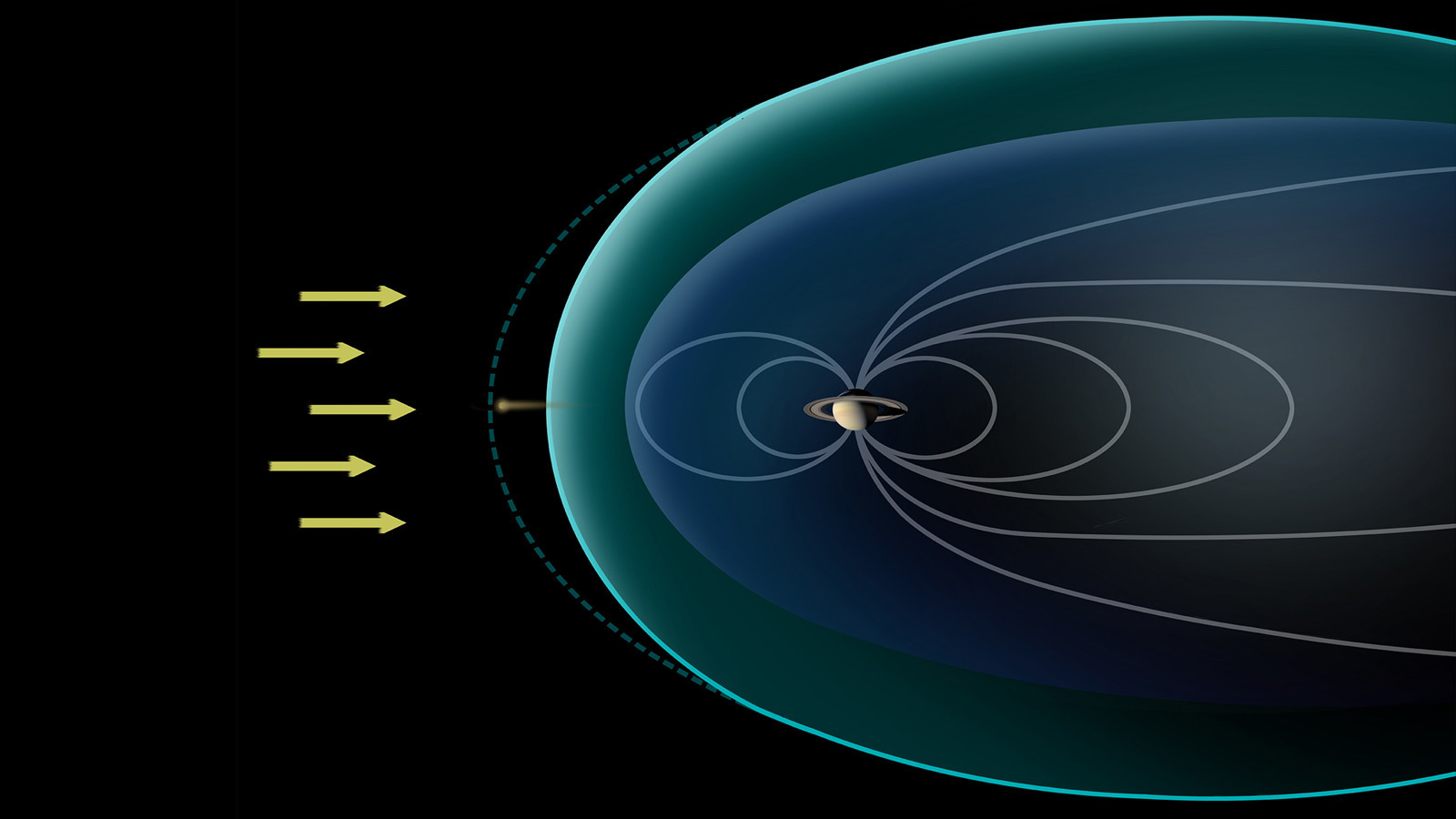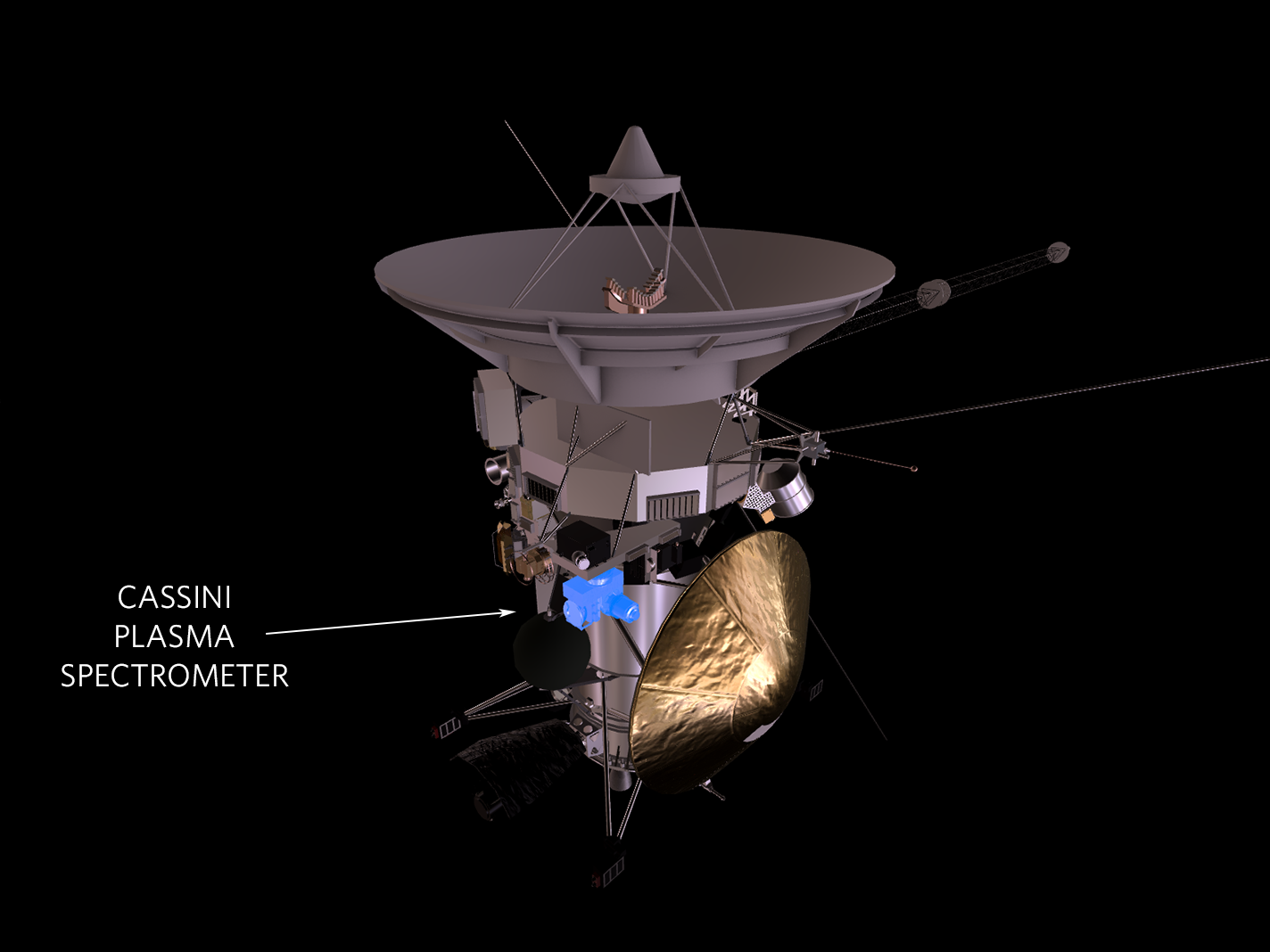
How It Worked
When particles approached the Cassini Plasma Spectrometer, known as CAPS, they could travel into one of three sensors: the electron sensor, the ion mass spectrometer, or the ion beam sensor. All three sensors measured the particle’s kinetic energy (a result of its mass and speed), and the direction the particle was traveling. But the ion mass spectrometer also measured the particle’s mass.
How We Used It
The shape and tilt of the Cassini spacecraft’s orbit around Saturn changed frequently -- at times nearer and farther; sometimes around Saturn’s equator, and at other times over the poles. The ever-changing orbit allowed CAPS to sample ions and electrons in a variety of regions around Saturn, and scientists use the instrument’s data to learn about the composition, density, flow, velocity and temperature of ions and electrons in Saturn's huge, bullet-shaped magnetosphere.
Cassini’s Plasma Spectrometer, called CAPS, was an in situ instrument, detecting and analyzing plasma (ions and electrons) in the vicinity of the spacecraft. Scientists have used the instrument’s data to learn about the composition, density, flow, velocity and temperature of ions and electrons in Saturn's magnetosphere.
By measuring the composition of the ions, CAPS helped determine the sources of plasma in the magnetosphere. One of CAPS’ major discoveries was that most of the ions in the Saturn system come from water ejected by Saturn’s moon Enceladus. Before Cassini, some scientists thought most of the ions would be nitrogen-derived ions from Titan, but that turned out not to be the case.
The instrument was of vital importance at Titan, where CAPS sensed large charged particles (which turned out to be negatively-charged ions) that play an important role in the formation of aerosols in the moon's atmosphere. “Titan’s upper atmosphere is creating all these complex organics that end up on the surface, and the CAPS electron sensor was an essential part of understanding part of that organic process,” said Hunter Waite, principal investigator for the CAPS instrument and a planetary scientist at the Southwest Research Institute.
The organic molecules fall from the atmosphere onto the surface of Titan where wind slowly piles them into dunes. Titan’s dune fields cover an area the size of the U.S. on a moon barely bigger than planet Mercury, and so they dominate Titan’s equatorial latitudes.
CAPS could only detect particles that physically collided with its detectors, meaning the only way for it to study Titan’s atmosphere was to fly through it. But that’s less hazardous than it might sound.
Though it has a dense, hazy atmosphere, Titan is only a little bigger than Earth’s moon, so it has less gravity than Earth and doesn’t compress its atmosphere as much. That allows its atmosphere’s wispy upper layers to reach well into space where Cassini’s CAPS instrument could have a taste without much danger from atmospheric drag.
The CAPS instrument also found giant fingers of cold, heavy plasma moving outward from the orbit of Enceladus, while hot and light plasma moves inward between the fingers. The fingers of plasma appear to be a fundamental feature of Saturn’s magnetosphere.
Like Earth, Saturn spins, and the rate at which it spins determines the length of its day. The exact length of a Saturn day isn’t known to the minute, but scientists still have piles of evidence that say a Saturn day lasts in the neighborhood of 10.7 Earth-hours. So despite being more than nine times the diameter of Earth, Saturn spins so fast that a day there lasts less than half an Earth day.
Since Saturn’s core produces its magnetic field, the magnetic field must rotate at the same speed as the core, and electrically charged particles flow along with magnetic fields. So Saturn’s fast rate of rotation means that the particles in its magnetic field -- they're technically called a plasma -- are whipping through space at a wild sprint.
Cassini scientists found that the bulk of plasma particles in Saturn’s magnetosphere originate at the moon Enceladus, which vents water and other matter from jets in its south polar region. When exposed to the magnetosphere and to ultraviolet sunlight in space, the ejected particles become ionized, meaning they acquire an electric charge. “Once a particle is charged, it responds to the rotation of the planet’s magnetosphere,” Waite said, and so the charged particles from Enceladus begin circling Saturn under the influence of the magnetic field.
“If you have stuff in a centrifuge, the heavy stuff gets pulled to the outside,” Waite said. “And this is a centrifuge.” So the heavier plasma particles around Saturn are being pulled outward and wedging the lighter matter inward. That’s how the fingers of plasma form outward of Enceladus, the scientists have found.
CAPS also found that the plasma in Saturn’s magnetosphere slows down when it interacts with the Enceladus plume by a process called “momentum transfer,” which happens in two ways.
In one interaction, fast-moving ions traveling in tight circles about Saturn’s magnetic field lines collide with the slower-moving neutral particles spraying up in the plume. When they collide, ions steal electrons from neutral particles -- the neutral particle acquires a positive charge because it loses an electron, while the fast-moving ion becomes neutral because it gains an electron.
In another interaction, nano-size grains of water ice condense while exiting the vents on Enceladus. Then, fast-moving electrons in Saturn’s magnetosphere collect on the ice grains, adding mass and giving the grains a negative charge.
The particles were observed by the CAPS electron sensor. The sensor wasn’t designed to measure dust, but, like electrons, the dust particles have a negative electric charge. And even though they are much, much more massive than an electron, they are also moving much, much slower than magnetospheric electrons; in the Enceladus plume, they have the same energy per charge as an electron moving at one-tenth the speed of light, and so they show up in the CAPS electron sensor’s measurements.
Though the ice grains are so tiny that they’re classified as dust, they’re much larger (and move more slowly) than most magnetospheric plasma particles, which are only between one and three atoms. A single dust particle wouldn’t affect the behavior of the plasma much, but Enceladus’ plume contains countless dust particles, and so the charged dust slows down the local plasma motion. “It changes the collective behavior of the plasma,” Waite said. The interaction of dust and plasma is unusual and Waite describes it as “a unique dusty plasma process.”
CAPS data has also been used to study Saturn’s rings, starting on the day the spacecraft entered Saturn orbit in 2004. During the orbit insertion maneuver, Cassini flew over the planet’s main rings and even passed through one of its sparser outer rings, the G ring. This was the first direct sampling of plasma over Saturn’s main rings. CAPS data suggests that the rings are engulfed in an extremely thin atmosphere of ionized molecular oxygen (O2) and “water group” ions such as H2O+ and OH+, which form after ultraviolet light from the sun strips water molecules from ring particles, and then the molecules then get ionized in the same way as those ejected from Enceladus.
Well-earned Retirement
Rarely does a single instrument ‘discover’ something conclusive on its own. Scientists typically combine or compare one instrument’s observations with data from others for context and to better understand what the instrument detected. Since scientists depend on that interplay between instruments, it was unfortunate that CAPS had to be turned off.
The spectrometer suffered a series of short circuits beginning in 2011. Engineers and scientists working together initially decided that the instrument would not harm the spacecraft, so they turned CAPS back on in early 2012. The instrument then operated smoothly for 78 days until a far more serious short-circuit tripped the equivalent of a circuit breaker and turned the instrument off. After further study, the team decided that turning the instrument on again would only result in another short, so they left CAPS off thereafter.
However, by the time the plasma spectrometer malfunctioned, it had already operated successfully for about double the length of Cassini’s original four-year mission at Saturn, in addition to its nearly seven-year journey to get there. The scientific data CAPS collected contributed to new revelations about the moons Titan and Enceladus, the source of plasma in Saturn’s magnetosphere, and much more.

At A Glance
- Mass = 12.50 kg
- Average Operating Power = 14.50 W
- •Data rate: 0.5 kilobits/s (survey) to 16 kbps (encounters/selected perisapsis)
Cassini Orbiter Instruments
They surveyed and sniffed, analyzed and scrutinized. They took stunning images in various visible spectra. Cassini's 12 science instruments were designed to carry out sophisticated scientific studies of Saturn, from collecting data in multiple regions of the electromagnetic spectrum, to studying dust particles, to characterizing Saturn's plasma environment and magnetosphere.
Optical Remote Sensing
Mounted on the remote sensing pallet, these instruments studied Saturn and its rings and moons in the electromagnetic spectrum.
Fields, Particles and Waves
These instruments studied the dust, plasma and magnetic fields around Saturn. While most didn't produce actual "pictures," the information they collected is critical to scientists' understanding of this rich environment.
Microwave Remote Sensing
Using radio waves, these instruments mapped atmospheres, determined the mass of moons, collected data on ring particle size, and unveiled the surface of Titan.





